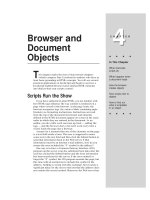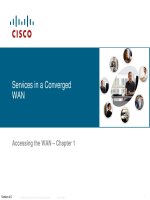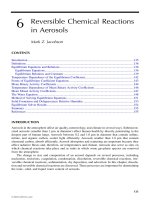Accessing the WAN – Chapter 4 docx
Bạn đang xem bản rút gọn của tài liệu. Xem và tải ngay bản đầy đủ của tài liệu tại đây (2.05 MB, 61 trang )
© 2006 Cisco Systems, Inc. All rights reserved. Cisco Public ITE I Chapter 6
1
Network Security
Accessing the WAN – Chapter 4
Cisco Thai Nguyen Networking Academy
© 2006 Cisco Systems, Inc. All rights reserved. Cisco Public ITE 1 Chapter 6
2
Objectives
In this chapter, you will learn to:
– Identify security threats to enterprise networks
– Describe methods to mitigate security threats to enterprise
networks
– Configure basic router security
– Disable unused router services and interfaces
– Use the Cisco SDM one-step lockdown feature
– Manage files and software images with the Cisco IOS
Integrated File System (IFS)
Cisco Thai Nguyen Networking Academy
© 2006 Cisco Systems, Inc. All rights reserved. Cisco Public ITE 1 Chapter 6
3
Why is Network Security Important?
Computer networks have grown in both
size and importance in a very short time.
–If the security of the network is compromised,
there could be serious consequences, such as
loss of privacy, theft of information, and even
legal liability.
In this chapter You will learn about
–different types of threats,
–the development of organizational security
policies, mitigation techniques,
–Cisco software tools to help secure networks.
–managing Cisco IOS software images.
•Although this may not seem like a security issue,
Cisco software images and configurations can be
deleted. Devices compromised in this way pose
security risks.
Cisco Thai Nguyen Networking Academy
© 2006 Cisco Systems, Inc. All rights reserved. Cisco Public ITE 1 Chapter 6
4
The Increasing Threat to Security
Over the years, tools and methods have evolved.
–In 1985 an attacker had to have sophisticated
computer, knowledge to make tools and basic attacks.
–As time went on, and attackers' tools improved,
attackers no longer required the same level knowledge.
Some of the most common terms are as follows:
–White hat - An individual who looks for vulnerabilities
in systems and reports these so that they can be fixed.
–Black hat - An individuals who use their knowledge to
break into systems that they are not authorized to use.
–Hacker - An individual that attempts to gain
unauthorized access to network with malicious intent.
–Cracker - Someone who tries to gain unauthorized
access to network resources with malicious intent.
–Phreaker - Individual who manipulates phone network,
through a payphone, to make free long distance calls.
–Spammer - An individual who sends large quantities of
unsolicited e-mail messages.
–Phisher - Uses e-mail or other means to trick others
into providing information, such as credit card numbers.
Cisco Thai Nguyen Networking Academy
© 2006 Cisco Systems, Inc. All rights reserved. Cisco Public ITE 1 Chapter 6
5
Think Like a Attacker
Many attackers use this seven-step process to gain information and
state an attack.
–Step 1. Perform footprint analysis (reconnaissance).
•Company webpage can lead to information, such as IP addresses of servers.
–Step 2. Enumerate information.
•An attacker can expand on the footprint by monitoring network traffic with a
packet sniffer such as Wireshark, finding information such as version of servers.
–Step 3. Manipulate users to gain access.
•Sometimes employees choose passwords that are easily crackable.
–Step 4. Escalate privileges.
•After attackers gain basic access, they use their skills to increase privileges.
–Step 5. Gather additional passwords and secrets.
•With improved privileges, attackers gain access to sensitive information.
–Step 6. Install backdoors.
•Backdoors provide the attacker to enter the system without being detected.
–Step 7. Leverage the compromised system.
•After a system is compromised, attacker uses it to attack others in the network.
Cisco Thai Nguyen Networking Academy
© 2006 Cisco Systems, Inc. All rights reserved. Cisco Public ITE 1 Chapter 6
6
Types of Computer Crime
These are the most commonly reported acts of computer crime that
have network security implications. In certain countries, some of these
activities may not be a crime, but are still a problem.
–Insider abuse of network
access
–Virus
–Mobile device theft
–Phishing where an
organization is fraudulently
represented as the sender
–Instant messaging misuse
–Denial of service
–Unauthorized access to
information
–Bots within the organization
–Theft of customer or employee
data
–Abuse of wireless network
–System penetration
–Financial fraud
–Password sniffing
–Key logging
–Website defacement
–Misuse of a public web
application
–Theft of proprietary information
–Exploiting the DNS server of
an organization
–Telecom fraud
–Sabotage
Cisco Thai Nguyen Networking Academy
© 2006 Cisco Systems, Inc. All rights reserved. Cisco Public ITE 1 Chapter 6
7
Open versus Closed Networks
The overall security challenge facing network
administrators is balancing two important needs:
–keep networks open to support business
requirements
–Protect private, personal, and business
information.
Network security models is a progressive scale
–From open-any service is permitted unless it is
expressly denied.
–To restrictive-services are denied by default unless
deemed necessary.
–An extreme alternative for managing security is to
completely close a network from the outside world.
•Because there is no outside connectivity, networks are
considered safe from outside attacks.
•However, internal threats still exist. A closed network
does little to prevent attacks from within the enterprise.
Cisco Thai Nguyen Networking Academy
© 2006 Cisco Systems, Inc. All rights reserved. Cisco Public ITE 1 Chapter 6
8
Developing a Security Policy
First step an organization should take to protect its data and
a liability challenge is to develop a security policy.
A security policy meets these goals:
–Informs users, staff, and managers of their requirements for
protecting information assets
–Specifies the mechanisms through which these requirements
can be met
–Provides a baseline from which to acquire, configure, and audit
computer systems for compliance
Assembling a security policy can be daunting. The ISO and
IEC have published a security standard document called
ISO/IEC 27002. The document consists of 12 sections:
–Risk assessment
–Security policy
–Organization of information security
–Asset management
–Human resources security
–Physical and environmental security
–Communications and operations management
–Access control
–Information systems acquisition, development,
and maintenance
–Information security incident management
–Business continuity management
–Compliance
Cisco Thai Nguyen Networking Academy
© 2006 Cisco Systems, Inc. All rights reserved. Cisco Public ITE 1 Chapter 6
9
Vulnerabilities
When discussing network security, 3 factors
are vulnerability, threat, attack.
–Vulnerability: it is the degree of weakness
which is inherent in every network and device.
•Routers, switches, desktops, and servers.
–Threats: They are the people interested in
taking advantage of each security weakness.
–Attack: The threats use a variety of tools, and
programs to launch attacks against networks.
There are 3 primary vulnerabilities:
–Technological weaknesses
•Computer and network technologies have
intrinsic security weaknesses. These include
operating system, and network equipment.
–Configuration weaknesses
•Network administrators need to learn what the
configuration weaknesses are.
–Security policy weaknesses
•Security risks to the network exist if users do not
follow the security policy.
Cisco Thai Nguyen Networking Academy
© 2006 Cisco Systems, Inc. All rights reserved. Cisco Public ITE 1 Chapter 6
10
Threats to Physical Infrastructure
A less glamorous, but no less important, class of threat is the
physical security of devices. An attacker can deny the use of
network resources if those resources can be physically
compromised.
The four classes of physical threats are:
–Hardware threats - Physical damage to servers, routers, switches,
cabling plant, and workstations
–Environmental threats - Temperature extremes (too hot or too cold) or
humidity extremes (too wet or too dry)
–Electrical threats - Voltage spikes, insufficient supply voltage
(brownouts), unconditioned power (noise), and total power loss
–Maintenance threats - Poor handling of key electrical components
(electrostatic discharge), lack of critical spare parts, poor cabling, and
poor labeling
Here are some ways to mitigate physical threats:
Cisco Thai Nguyen Networking Academy
© 2006 Cisco Systems, Inc. All rights reserved. Cisco Public ITE 1 Chapter 6
11
Threats to Networks
There are 4 primary classes of threats to networks:
Unstructured Threats
–Unstructured threats consist of mostly inexperienced
individuals using easily available hacking tools, such as
shell scripts and password crackers.
Structured Threats
–Structured threats come from individuals or groups that are
more highly motivated and technically competent.
–They break into business computers to commit fraud,
destroy or alter records, or simply to create havoc.
External Threats
–External threats can arise from individuals or organizations
working outside of a company who do not have authorized
access to the computer systems or network.
Internal Threats
–Internal threats occur when someone has authorized
access to the network with either an account or physical
access.
Cisco Thai Nguyen Networking Academy
© 2006 Cisco Systems, Inc. All rights reserved. Cisco Public ITE 1 Chapter 6
12
Social Engineering
The easiest hack involves no computer skill.
–If an intruder can trick a member of an
organization into giving over information, such as
the location of files or passwords, the process of
hacking is made much easier.
Phishing is a type of social engineering attack
that involves using e-mail in an attempt to trick
others into providing sensitive information, such
as credit card numbers or passwords.
–Frequently, phishing scams involve sending out
spam e-mails that appear to be from known online
banking or auction sites.
–These e-mails contain hyperlinks that appear to
be legitimate, but actually take users to a fake
website set up by the phisher to capture their
information.
–Phishing attacks can be prevented by educating
users and implementing reporting guidelines when
they receive suspicious e-mail.
Cisco Thai Nguyen Networking Academy
© 2006 Cisco Systems, Inc. All rights reserved. Cisco Public ITE 1 Chapter 6
13
Types of Network Attacks
There are four primary classes of attacks.
Reconnaissance
–Reconnaissance is the unauthorized discovery and
mapping of systems, services, or vulnerabilities.
–It is also known as information gathering.
–Reconnaissance is similar to a thief casing a
neighborhood for vulnerable homes to break into.
Access
–System access is the ability for an intruder to gain access
to a device for which the intruder does not have password.
Denial of Service
–Denial of service (DoS) is when an attacker disables or
corrupts networks, systems, with the intent to deny
services to intended users.
–For these reasons, DoS attacks are the most feared.
Worms, Viruses, and Trojan Horses
–Malicious software can be inserted onto a host to damage
or corrupt a system, replicate itself, or deny access to
networks, systems, or services.
Cisco Thai Nguyen Networking Academy
© 2006 Cisco Systems, Inc. All rights reserved. Cisco Public ITE 1 Chapter 6
14
Reconaissance Attacks
Reconnaissance attacks can consist of:
–Internet information queries
•External attackers can use Internet tools, such as the
nslookup and whois utilities, to easily determine the IP
address space assigned to a given corporation or entity.
–Ping sweeps
•After the IP address space is determined, an attacker
can then ping the publicly available IP addresses to
identify the addresses that are active.
•An attacker may use a ping sweep tool, such as fping or
gping, pings all network addresses in a given subnet.
–Port scans
•When the active IP addresses are identified, the
intruder uses a port scanner to determine which network
services or ports are active on the live IP addresses.
•A port scanner is software, such as Nmap or
Superscan, is designed to search a host for open ports.
•The port scanner queries the ports to determine the
application and version, as well as the version of OS.
–Packet sniffers
Cisco Thai Nguyen Networking Academy
© 2006 Cisco Systems, Inc. All rights reserved. Cisco Public ITE 1 Chapter 6
15
Reconaissance Attacks
Packet sniffers: Internal attackers may attempt to
"eavesdrop" on network traffic.
–Two common uses of eavesdropping are as follows:
•Information gathering - Network intruders can identify
usernames, passwords, or information carried in a packet.
•Information theft - The network intruder can also steal data from
networked computers by gaining unauthorized access.
–A common method for eavesdropping is to capture TCP/IP
or other protocol packets and decode the contents.
•An example of such a program is Wireshark.
•It can capture usernames and passwords as they cross network.
–Three of the most effective methods for counteracting
eavesdropping are as follows:
•Using switched networks instead of hubs so that traffic is not
broadcast to all endpoints or network hosts.
•Using encryption that meets the data security needs without
imposing an excessive burden on system resources or users.
•Forbids the use of protocols with known susceptibilities to
eavesdropping. SNMP version 3 can encrypt community strings.
Cisco Thai Nguyen Networking Academy
© 2006 Cisco Systems, Inc. All rights reserved. Cisco Public ITE 1 Chapter 6
16
Access Attacks
Access attacks exploit vulnerabilities in
authentication, FTP, and web to gain entry to
accounts, confidential, and sensitive information.
Password Attacks
–Password attacks usually refer to repeated attempts to
log in to a server, to identify a user account, password.
–These repeated attempts are called dictionary attacks
or brute-force attacks.
•Password attacks can be mitigated by educating users to
use long, complex passwords.
–To conduct a dictionary attack, attackers can use tools
such as L0phtCrack or Cain or rainbow tables.
Trust Exploitation
–If a host in a network of a company is protected by a
firewall (inside host), but is accessible to a trusted host
outside the firewall (outside host), the inside host can be
attacked through the trusted outside host.
–For example, private VLANs can be deployed in public-
service segments where multiple public servers are
available.
Cisco Thai Nguyen Networking Academy
© 2006 Cisco Systems, Inc. All rights reserved. Cisco Public ITE 1 Chapter 6
17
Access Attacks
Port Redirection
–A port redirection is a type of trust exploitation
attack that uses a compromised host to pass
traffic through a firewall.
–An utility that can provide this type of access is
netcat.
–Port redirection can be mitigated through the
use a host-based intrusion detection system
(IDS).
Cisco Thai Nguyen Networking Academy
© 2006 Cisco Systems, Inc. All rights reserved. Cisco Public ITE 1 Chapter 6
18
Access Attacks
Man-in-the-Middle Attack
–A man-in-the-middle (MITM) attack is carried out by
attackers that position themselves between two hosts.
–An attacker may catch a victim with a phishing e-mail
or by defacing a website. For instance
http:www.legitimate.com becomes
http:www.attacker.com/.
•1. When a victim requests a webpage, the host of the
victim makes the request to the host of the attacker's.
•2. The attacker's host receives the request and fetches
the real page from the legitimate website.
•3. The attacker can alter the legitimate webpage and
apply any transformations to the data they want to make.
•4. The attacker forwards the requested to the victim
.
–WAN MITM attack mitigation is achieved using VPN.
–LAN MITM attacks use tools ettercap and ARP
poisoning.
•It can be mitigated by using port security on LAN
switches.
Cisco Thai Nguyen Networking Academy
© 2006 Cisco Systems, Inc. All rights reserved. Cisco Public ITE 1 Chapter 6
19
DoS Attacks
DoS attacks are the most publicized form of attack
and also among the most difficult to eliminate.
–DoS attacks prevent authorized people from using a
service by consuming system resources.
Ping of Death
–A ping is normally 64 (84 bytes with the header).
–The IP packet size could be up to 65,535 bytes.
–A ping of this size may crash an older computer.
SYN Flood
–A SYN flood attack exploits the TCP 3-way handshake.
•It sending multiple SYN requests to a targeted server.
•The server replies with SYN-ACK, but the malicious host
never responds the ACK to complete the handshake.
•This ties up the server until it runs out of resources
.
E-mail bombs
–Programs send bulk e-mails monopolizing services.
Malicious applets
–These attacks are Java, JavaScript, or ActiveX that
cause destruction or tie up computer resources.
Cisco Thai Nguyen Networking Academy
© 2006 Cisco Systems, Inc. All rights reserved. Cisco Public ITE 1 Chapter 6
20
DDoS Attacks
Distributed DoS (DDoS) attacks are designed to
saturate network links with illegitimate data.
–Typically, there are 3 components to a DDoS attack.
•A Client who is typically a person who launches the attack.
•A Handler is a compromised host that control multiple Agents
•An Agent is a compromised host that responsible for
generating packets that toward the intended victim
Examples of DDoS attacks include the following:
–SMURF attack
–Tribe flood network (TFN)
–Stacheldraht
–MyDoom
The Smurf attack uses spoofed broadcast ping
messages to flood a target system. It starts with an
attacker sending a large number of ICMP echo
requests to the network broadcast address from valid
spoofed source IP addresses.
–Turning off directed broadcast capability prevents the
network from being used as a bounce site.
Cisco Thai Nguyen Networking Academy
© 2006 Cisco Systems, Inc. All rights reserved. Cisco Public ITE 1 Chapter 6
21
Malicious Code Attacks
The primary vulnerabilities for end-user workstations are
worm, virus, and Trojan horse attacks.
–A worm executes code and installs copies of itself in the
infected computer, which can infect other hosts.
•A worm installs itself by exploiting known vulnerabilities in
systems, such as naive end users who open unverified
executable attachments in e-mails
–A virus is malicious software that is attached to another
program for the purpose of executing a particular unwanted
function on a workstation.
•An example is a program that is attached to command.com and
deletes files and infects any other versions of command.com.
–A Trojan horse is that the entire application was written to
look like something else, when in fact it is an attack tool.
•Example of a Trojan horse is a software that runs a game.
While the user is occupied with the game, the Trojan horse
mails a copy of itself to every address in the user's address
book.
These kinds of applications can be contained through
the effective use of antivirus software at the user level,
and potentially at the network level.
Cisco Thai Nguyen Networking Academy
© 2006 Cisco Systems, Inc. All rights reserved. Cisco Public ITE 1 Chapter 6
22
Host and Server Based Security: Device Hardening
When a new operating system is installed on a
computer, the level of security is inadequate. There
are some simple steps that should be taken :
–Default usernames and passwords should be
changed.
–Access to system resources should be restricted to
only the individuals that are authorized.
–Any unnecessary services should be turned off.
Additional steps can be taken to secure hosts:
Antivirus, firewall, and intrusion detection tools.
Antivirus Software
–Antivirus software to protect against known viruses.
Antivirus software does this in two ways:
•It scans files, comparing their contents to known viruses
in a virus dictionary. Matches are flagged in a manner
defined by the end user.
•It monitors suspicious processes running on a host that
might indicate infection.
Cisco Thai Nguyen Networking Academy
© 2006 Cisco Systems, Inc. All rights reserved. Cisco Public ITE 1 Chapter 6
23
Host and Server Based Security: Device Hardening
Personal Firewall
–Personal computers connected to the Internet through
a dialup, DSL, or cable modems are vulnerable.
•Personal firewalls on the PC can prevent attacks.
•Some personal firewall software vendors include McAfee,
Norton, Symantec, and Zone Labs.
Operating System Patches
–The most effective way to mitigate a worm and its
variants is to download security updates and patch all
vulnerable systems.
–This is difficult with uncontrolled systems in the local
network, and even more troublesome if these systems
are remotely connected via a VPN.
–One solution to the management of security patches
is to create a central patch server that all systems must
communicate.
•Any patches that are not applied to a host are
automatically downloaded from the patch server and
installed without user intervention.
Cisco Thai Nguyen Networking Academy
© 2006 Cisco Systems, Inc. All rights reserved. Cisco Public ITE 1 Chapter 6
24
Host and Server Based Security: Device Hardening
Intrusion Detection and Prevention
–Intrusion detection systems (IDS) detect attacks and
send logs to a management console.
–Intrusion prevention systems (IPS) prevent attacks.
It provides the following active defense:
•Prevention - Stops the detected attack from executing.
•Reaction - Immunizes the system from future attacks.
–Either technology can be implemented at a network
or host level, or both for maximum protection.
Host-based Intrusion Detection Systems (HIDS)
–Host-based intrusion is passive technology.
•HIDS sends logs to a management console after the
attack has occurred and the damage is done.
Host-based intrusion prevention system (HIPS),
–HIPS stops the attack, and prevents damage.
–Cisco provides HIPS using the Security Agent software.
–Agents are installed on publicly accessible servers and
corporate mail and application servers.
Cisco Thai Nguyen Networking Academy
© 2006 Cisco Systems, Inc. All rights reserved. Cisco Public ITE 1 Chapter 6
25
Common Security Appliances and Applications
Network-based intrusion prevention system (HIPS)
A firewall by itself is no longer adequate.
–An integrated approach involving firewall, intrusion
prevention, and VPN is necessary.
An integrated approach follows these building blocks:
–Threat control - Regulates network access, prevents
intrusions, by counteracting malicious traffic.
•Cisco ASA 5500 Series Adaptive Security Appliances
•Integrated Services Routers (ISR)
•Network Admission Control
•Cisco Security Agent for Desktops
•Cisco Intrusion Prevention Systems
–Secure communications - Secures network endpoints
with VPN.
•Cisco ISR routers with Cisco IOS VPN solution,
•Cisco 5500 ASA
•Cisco Catalyst 6500 switches.
–Network admission control (NAC) - Provides a roles-
based method of preventing unauthorized access









